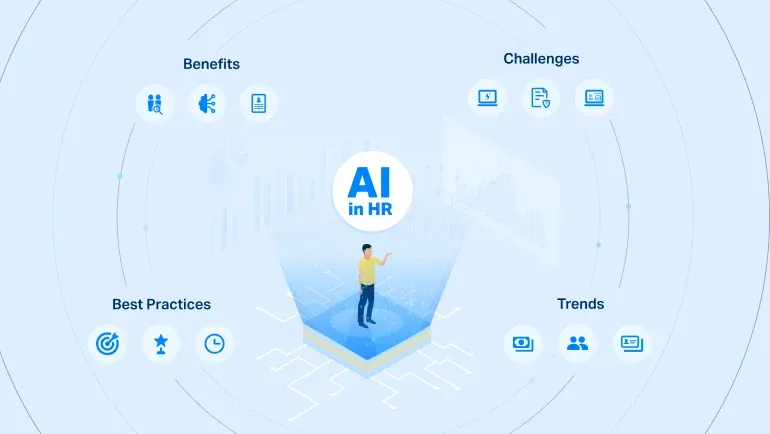AI in HR: Automating Leave, Payroll and Offboarding

Human Resources is one of the most time-consuming departments in modern businesses. HR teams often drown in manual approvals, payroll corrections, and offboarding checklists. This slows down decision making, increases compliance risk, and frustrates employees. The solution is not hiring more staff but introducing AI-powered automation that streamlines repetitive HR operations.
Why Manual HR Processes Hold Companies Back
Even scale-ups with advanced CRM and ERP systems still manage HR tasks through email threads and spreadsheets. Common bottlenecks include:
- Leave requests that require multiple emails before approval
- Payroll data scattered across tools without validation
- Offboarding checklists that get overlooked, leaving access risks behind
These inefficiencies cost time, money, and employee trust. Companies that fail to automate face higher compliance risks and unnecessary overhead.
Automating Leave Requests
Leave approvals are a classic example of wasted HR hours. AI-driven workflows can:
- Capture leave requests through Slack, Teams, or HR portals
- Validate balances against policy and contracts
- Route approvals instantly to managers
- Update payroll systems in real time
- Notify employees automatically
This shifts the turnaround time from days to minutes. It also eliminates errors where employees take leave without balance checks or payroll alignment.
Payroll Compliance Without the Stress
Payroll compliance errors are among the most expensive mistakes an HR department can make. Automated workflows with AI can:
- Reconcile payroll data with attendance logs
- Detect anomalies such as unpaid overtime or incorrect deductions
- Generate compliance reports on demand
- Alert finance and HR teams before cut-off dates
By doing the heavy lifting automatically, companies avoid fines and disputes while saving hours of manual verification.
Offboarding That Protects the Business
When employees leave, companies face two big risks: data leakage and incomplete paperwork. AI automation solves this by:
- Revoking access to systems on the last working day
- Triggering knowledge-transfer reminders
- Collecting exit surveys without HR chasing employees
- Ensuring legal and compliance documents are signed and archived
A smooth offboarding flow not only protects company data but also strengthens employer branding.
Integration With HR Tech Stacks
Most organizations already run HRIS or payroll systems such as Personio, BambooHR, or ADP. AI automation platforms like n8n, Make.com, or custom middleware connect these systems seamlessly. That means no rip-and-replace; the automation layers on top of what is already in use.
Sector Examples
- Healthcare: Automating staff leave ensures patient care schedules stay compliant with labor laws.
- Retail: High seasonal turnover makes offboarding automation critical to protect POS access.
- Tech scale-ups: Payroll anomaly detection reduces disputes in fast-growing, distributed teams.
By tailoring automation to industry challenges, HR operations become an enabler of growth rather than a bottleneck.
ROI and Business Impact
The business case for AI in HR is clear:
- 70% reduction in admin workload through workflow automation
- Faster compliance audits with auto-generated reports
- Improved employee satisfaction from faster responses and transparency
- Lower risk exposure in payroll disputes and data breaches
Instead of spending weeks on paperwork, HR can focus on retention, talent strategy, and culture building.
Implementation Roadmap
- Audit HR processes – map leave, payroll, and offboarding tasks.
- Identify integration points – HRIS, payroll, collaboration platforms.
- Design workflows – approvals, anomaly detection, compliance triggers.
- Pilot with one process – e.g., automate leave requests first.
- Scale gradually – expand to payroll and offboarding, measure ROI.
This phased approach avoids disruption and shows quick wins to stakeholders.
Future of HR Automation
The next wave will bring predictive HR workflows. AI will not just process requests but anticipate them:
- Suggesting optimal leave schedules to avoid staffing gaps
- Forecasting payroll budgets months ahead
- Predicting turnover risks to trigger retention workflows
Companies that adopt automation now will be ready to integrate predictive HR sooner than competitors.
How Scalevise Helps
At Scalevise we design HR automation solutions that fit the unique challenges of your business. Whether you need a quick leave-approval bot, payroll compliance automation, or full offboarding orchestration, we deliver scalable workflows. Contact us to discuss how automation can transform your HR operations.
Conclusion
HR automation is not about replacing people but freeing them from repetitive work. By automating leave requests, payroll compliance, and offboarding, companies cut costs, reduce risks, and empower HR to focus on strategy. The organizations that move first will gain efficiency, compliance readiness, and happier employees.
